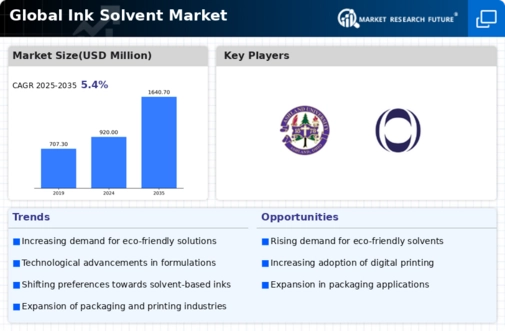Top Industry Leaders in the Ink Solvent Market

Ink Solvent Market
The world of printing wouldn't be as vibrant without the silent partners - ink solvents. These essential chemicals dissolve pigments and resins, giving life to the bold letters, captivating images, and intricate patterns that grace surfaces from newspapers to billboards. Navigating this dynamic landscape requires strategic brushstrokes and an unwavering commitment to innovation.
Key Strategies Shaping the Market:
-
Product Diversification: Leading players like Eastman Chemical Company, Dow Chemical, and BASF are continuously expanding their solvent portfolios, focusing on formulations catered to specific printing technologies (inkjet, flexo, gravure) and diverse substrates (paper, plastic, metal). This differentiation caters to niche markets and strengthens customer loyalty. -
Sustainability Focus: Environmental concerns surrounding traditional solvents like toluene and benzene are pushing manufacturers towards greener alternatives. Bio-based solvents derived from corn or soybeans, water-based inks, and UV-curable formulations are gaining traction. Sun Chemical's focus on developing plant-based solvents showcases this commitment to eco-friendly solutions. -
Technological Advancements: Continuous research and development in novel solvent formulations, improved purification processes, and advanced recycling technologies are vital for sustained growth. Evonik's recent breakthrough in using recycled carbon dioxide as a feedstock for solvent production exemplifies this innovative approach. -
Vertical Integration: Securing control over upstream resources like key petrochemicals is crucial for ensuring stable supply chains and cost competitiveness. Companies like ExxonMobil are actively pursuing vertical integration, gaining control over critical resources. -
Geographic Expansion: Emerging economies like China and India present immense potential for ink solvent consumption, driven by rapid growth in the packaging and printing industries. Companies like DIC Corporation are strategically building production facilities in these regions to capitalize on the expanding market.
Factors Dictating Market Share:
-
Brand Reputation and Reliability: Established players with proven track records like Flint Group and Tintas & Vernizes Iberia enjoy significant market share due to their brand recognition and consistent quality. However, innovative startups addressing specific environmental or performance needs can still carve out their space. -
Cost Competitiveness: Optimizing production processes and sourcing affordable raw materials are crucial for cost leadership. Asian manufacturers often have an edge due to lower labor costs, but premium brands command higher prices due to superior performance and environmental credentials. -
Technical Expertise and Support: Extensive knowledge of solvent properties, compatibility with different inks and printing technologies, and post-press troubleshooting support are essential for customer satisfaction and repeat business. Companies like Huber Group excel in this area. -
Regulatory Landscape: Stringent regulations on volatile organic compound (VOC) emissions and hazardous waste disposal are pushing manufacturers towards low-VOC and readily recyclable solvents. Adapting to evolving regulations and developing compliant products becomes crucial for market success.
Key Players:
Arkema S.A. (France), Ashland (U.S.), BASF SE (Germany), Celanese Corporation (U.S.), The Dow Chemical Company (U.S.), Eastman Chemical Company (U.S.), Evonik Industries AG (Germany), INEOS (U.K.), OMNOVA Solutions Inc (U.S.), and Royal Dutch Shell plc (the Netherlands) among others.
Industry News and Recent Developments:
ACTEGA, in October 2021, started launching a new product that has improved the haptic and visuality of glasses and containers. The coating of the containers has made them tangible and it has impactful shrink sleeve effects. Applying wet coating and Hybrid AQ-UV soft-touch coating has made the brand name popular. ACTEGA launched UV and certain solvent-based silver inks have given the product a metallic shine.
INX International Ink Co., on merging, has produced certain ink systems which have helped in meeting up the sustainability goals which was so launched by INCh RC RC. The innovation of the latest product has improved the performance of the ink systems. The merging of the company has led to the upsurging of clean, renewable, and sustainable ingredients. The launching of LED and UV inks has printed rigid, non-porous plastic which improved the demand for foam packaging units.
The popular Envases Group is the most dominating packaging supplier which has merged with the Denmark supplier. Some of the plants in Buenos Aires, Colombia, Cartagena, and San Luis have specialized in the launching of tinplate and aluminum cans. This company along with merging with Happa digital printer has enabled the units to provide safe and nitro-free alternatives of high printing quality. It has adopted the Nilpeter FA-22 technology.

